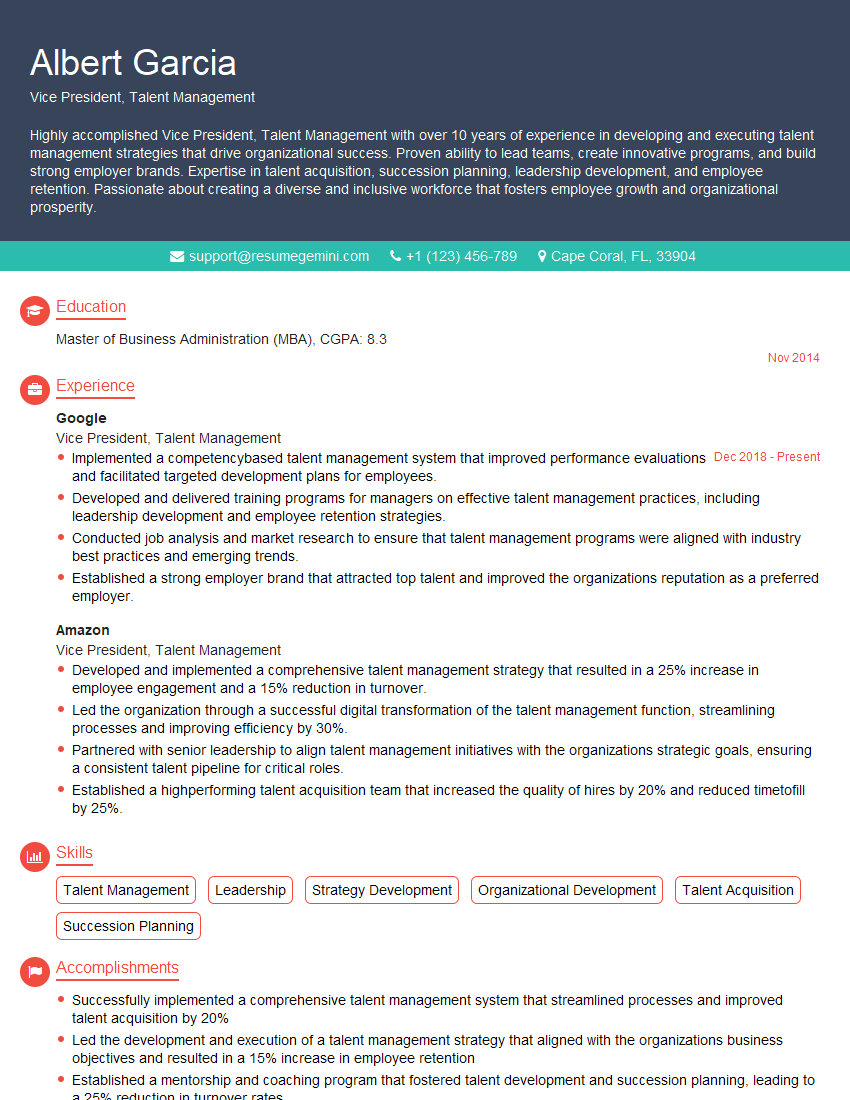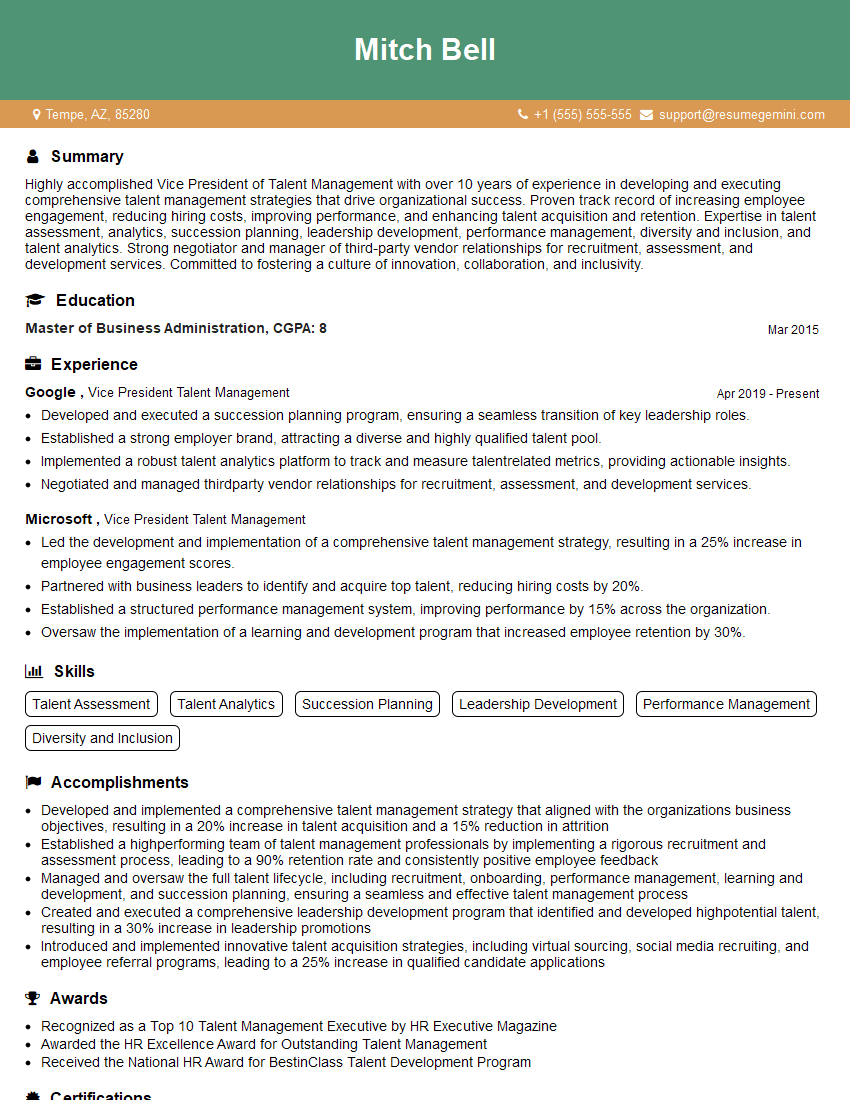Are you gearing up for a career shift or aiming to ace your next interview? Look no further! We’ve curated a comprehensive guide to help you crack the interview for the coveted Vice President, Talent Management position. From understanding the key responsibilities to mastering the most commonly asked questions, this blog has you covered. So, buckle up and let’s embark on this journey together
Acing the interview is crucial, but landing one requires a compelling resume that gets you noticed. Crafting a professional document that highlights your skills and experience is the first step toward interview success. ResumeGemini can help you build a standout resume that gets you called in for that dream job.
Essential Interview Questions For Vice President, Talent Management
1. Describe your approach to developing and implementing a talent management strategy.
In developing and implementing a talent management strategy, I begin by conducting a thorough assessment of the organization’s current talent landscape, including its strengths, weaknesses, and opportunities.
- Based on this assessment, I work with key stakeholders to define the organization’s talent needs and develop a strategy to address these needs.
- The strategy may include initiatives to attract, develop, and retain talent, as well as to improve the overall talent management process.
- I then work with a team of HR professionals and other stakeholders to implement the strategy and track its progress.
2. How do you measure the effectiveness of a talent management program?
Key performance indicators
- One way to measure the effectiveness of a talent management program is to track key performance indicators (KPIs) such as:
- Employee turnover rate
- Time to fill
- Employee engagement levels
- Quality of hire
Return on investment
- Another way to measure effectiveness is to calculate the return on investment (ROI) of the program.
- This can be done by comparing the costs of the program to the benefits it generates, such as increased employee productivity or reduced turnover.
3. What are the biggest challenges facing talent management today?
One of the biggest challenges facing talent management today is the increasing demand for skilled workers.
- As the economy continues to grow, organizations are competing for a limited pool of qualified candidates.
- This has led to a rise in employee turnover and has made it more difficult for organizations to attract and retain top talent.
- Another challenge is the changing nature of work.
- With the advent of new technologies and the globalization of the economy, organizations are increasingly looking for workers with new skills and experiences.
- This has put pressure on talent management professionals to develop new and innovative ways to attract and develop talent.
4. What are the latest trends in talent management?
One of the latest trends in talent management is the use of artificial intelligence (AI) and machine learning.
- AI can be used to automate tasks such as screening resumes and scheduling interviews.
- Machine learning can be used to identify patterns in data and make predictions about employee performance.
- These technologies are helping talent management professionals to be more efficient and effective in their work.
5. Describe a time when you successfully led a talent management initiative.
One time when I successfully led a talent management initiative was when I was responsible for developing and implementing a new employee onboarding program.
- The program was designed to help new employees transition smoothly into the organization and to get them up to speed quickly.
- I worked with a team of HR professionals and other stakeholders to develop the program, which included a variety of components such as:
- Orientation sessions
- Mentoring programs
- Training programs
- The program was a success and helped to reduce employee turnover and improve employee engagement.
6. Describe your experience with talent acquisition and development.
I have extensive experience with talent acquisition and development.
- In my previous role, I was responsible for developing and implementing a talent acquisition strategy that resulted in a 20% increase in the number of qualified candidates.
- I also developed and implemented a comprehensive employee development program that helped to increase employee retention by 15%.
7. How do you stay up-to-date on the latest trends in talent management?
I stay up-to-date on the latest trends in talent management by:
- Reading industry publications
- Attending conferences and webinars
- Networking with other talent management professionals
8. What are your thoughts on the future of talent management?
I believe that the future of talent management is bright.
- Organizations are increasingly recognizing the importance of talent management and are investing in developing their talent.
- I believe that we will see continued growth in the use of technology in talent management.
- I also believe that we will see a greater focus on employee experience and employee engagement.
9. What are your strengths and weaknesses as a Vice President of Talent Management?
My strengths as a Vice President of Talent Management include:
- Strong leadership and management skills
- Expertise in talent acquisition and development
- Proven track record of success in developing and implementing talent management strategies
- Excellent communication and interpersonal skills
My weaknesses include:
- I can sometimes be too detail-oriented
- I am always looking for ways to improve, so I can sometimes be hard on myself
10. Why are you interested in this position?
I am interested in this position because I am passionate about talent management and I believe that I have the skills and experience to be successful in this role.
- I am also attracted to the company’s mission and values and I believe that I can make a significant contribution to the organization.
Interviewers often ask about specific skills and experiences. With ResumeGemini‘s customizable templates, you can tailor your resume to showcase the skills most relevant to the position, making a powerful first impression. Also check out Resume Template specially tailored for Vice President, Talent Management.
Career Expert Tips:
- Ace those interviews! Prepare effectively by reviewing the Top 50 Most Common Interview Questions on ResumeGemini.
- Navigate your job search with confidence! Explore a wide range of Career Tips on ResumeGemini. Learn about common challenges and recommendations to overcome them.
- Craft the perfect resume! Master the Art of Resume Writing with ResumeGemini’s guide. Showcase your unique qualifications and achievements effectively.
- Great Savings With New Year Deals and Discounts! In 2025, boost your job search and build your dream resume with ResumeGemini’s ATS optimized templates.
Researching the company and tailoring your answers is essential. Once you have a clear understanding of the Vice President, Talent Management‘s requirements, you can use ResumeGemini to adjust your resume to perfectly match the job description.
Key Job Responsibilities
The Vice President of Talent Management is the strategic leader responsible for developing and executing the organization’s talent management strategy, which encompasses all aspects of talent acquisition, development, and retention. They play a critical role in attracting, developing, and retaining top talent, ensuring that the organization has the human capital it needs to achieve its strategic objectives.
1. Talent Acquisition
Oversee all aspects of talent acquisition, including developing and implementing sourcing strategies, managing the recruitment process, and ensuring a positive candidate experience.
- Develop and implement sourcing strategies to identify and attract top talent.
- Manage the recruitment process, including screening candidates, conducting interviews, and making hiring decisions.
2. Talent Development
Design and implement talent development programs to support the growth and development of employees at all levels of the organization.
- Design and implement talent development programs to support the growth and development of employees at all levels of the organization.
- Identify and develop high-potential employees and create opportunities for their growth and development.
3. Talent Retention
Develop and implement strategies to retain top talent and reduce employee turnover.
- Create a positive and engaging work environment that fosters employee retention.
- Identify and address the root causes of employee turnover and develop strategies to reduce it.
4. HR Strategy
Partner with senior leadership to develop and execute the organization’s overall HR strategy.
- Align talent management strategies with the organization’s overall business objectives.
- Work with other HR leaders to ensure that all HR functions are aligned and supporting the organization’s goals.
Interview Tips
Preparing for an interview for a Vice President of Talent Management position can be daunting, but with the right preparation, you can increase your chances of success significantly. Here are some tips to help you ace the interview.
1. Research the Company and the Role
Take the time to learn about the company’s culture, values, and business objectives. This will help you understand the company’s needs and how you can contribute to their success. Also, be sure to review the job description carefully and identify the key responsibilities and qualifications for the role.
- Visit the company’s website and social media pages to learn about their culture and values.
- Read recent news articles and press releases to understand the company’s business objectives.
2. Prepare for Behavioral Interview Questions
Behavioral interview questions are commonly used in interviews for Vice President of Talent Management positions. These questions focus on your past experiences and how you have handled specific situations. To prepare for these questions, think about your past experiences and identify examples that demonstrate your skills and abilities in the areas of talent acquisition, talent development, and talent retention.
- Use the STAR method to answer behavioral interview questions. STAR stands for Situation, Task, Action, and Result.
- When describing your experiences, focus on the results you achieved and the impact you had on your organization.
3. Practice Your Answers
Once you have prepared your answers to potential interview questions, practice delivering them out loud. This will help you become more comfortable with the questions and your answers and will help you to deliver your answers more confidently in the interview.
- Practice answering questions with a friend or family member.
- Record yourself answering questions and then watch the recording to identify areas for improvement.
4. Be Prepared to Talk About Your Experience
The interviewer will want to know about your experience in talent management. Be prepared to talk about your accomplishments in the areas of talent acquisition, talent development, and talent retention. Use specific examples to demonstrate your skills and abilities.
- Quantify your accomplishments whenever possible. For example, instead of saying “I developed a new talent acquisition strategy,” say “I developed a new talent acquisition strategy that resulted in a 20% increase in the number of qualified candidates.”
- Be prepared to discuss your experience in developing and implementing talent development programs.
Next Step:
Now that you’re armed with the knowledge of Vice President, Talent Management interview questions and responsibilities, it’s time to take the next step. Build or refine your resume to highlight your skills and experiences that align with this role. Don’t be afraid to tailor your resume to each specific job application. Finally, start applying for Vice President, Talent Management positions with confidence. Remember, preparation is key, and with the right approach, you’ll be well on your way to landing your dream job. Build an amazing resume with ResumeGemini

